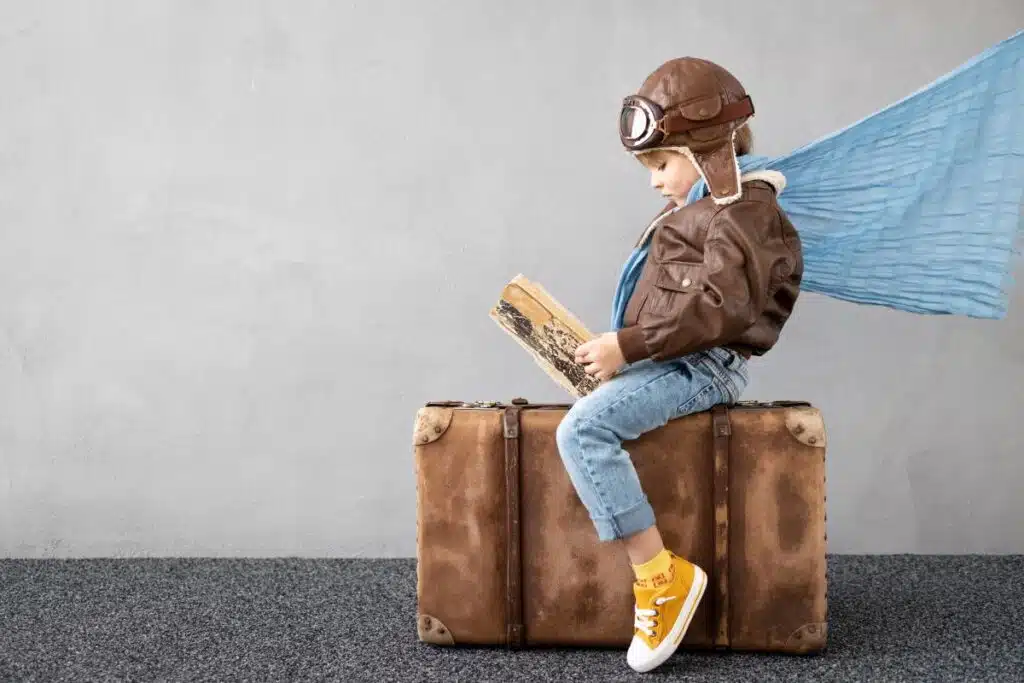In a world increasingly connected yet sometimes distant, children’s literature serves as a bridge to understanding diverse cultures, landscapes, and stories. Books that inspire travel can ignite the wanderlust in young readers, offering them a glimpse into worlds beyond their immediate surroundings. This guide curates a selection of children’s books that are not just stories but journeys—each set in a different country, each offering a unique cultural experience. These books are gateways to global exploration, encouraging curiosity, empathy, and a lifelong love of travel.
1. “The White Giraffe” by Lauren St. John

“The White Giraffe” is the first book in an exciting series that transports readers to the exotic landscapes of South Africa. The story follows Martine, a young girl who, after losing her parents, moves to live with her grandmother on a wildlife reserve. There, she discovers a mythical white giraffe and embarks on a magical journey of self-discovery and adventure. Lauren St. John’s vivid storytelling and detailed descriptions of the African wilderness bring the setting to life, offering young readers a glimpse into the challenges and beauty of living close to nature. The book tells an engaging story of friendship between a girl and a giraffe and touches on important themes such as conservation, belonging, and the mysteries of the natural world.
Insider’s Tip: After reading the book, encourage your child to learn more about South Africa’s wildlife and the importance of conservation efforts. This can be a great opportunity to explore documentaries or visit a local wildlife sanctuary to see some of the animals featured in the story, enhancing their understanding and appreciation of the natural world.
2. “Around the World with Mouk” by Marc Boutavant

Image Credit: Shutterstock / George Rudy
This vibrant book takes readers on a journey with Mouk, a lovable bear who travels across the globe from the bustling streets of Tokyo to the vast deserts of Australia. Illustrated with rich, colorful detail, “Around the World with Mouk” is filled with stickers and interactive elements that engage young readers, making them active participants in Mouk’s adventures. The book introduces children to cultural diversity, showcasing various customs, languages, and landscapes.
Insider’s Tip: Use the book as a starting point for a cultural exploration day at home. After reading about a particular destination, try cooking a simple dish from that country or learning a few words in the local language with your child.
3. “This Is How We Do It: One Day in the Lives of Seven Kids from Around the World” by Matt Lamothe

Image Credit: Shutterstock / Evgeny Atamanenko
Matt Lamothe’s “This Is How We Do It” follows the daily lives of seven children from Italy, Japan, Iran, India, Peru, Uganda, and Russia, offering a window into the unique and universal routines among children worldwide. Through detailed illustrations and simple narratives, readers learn about different cultures through the eyes of their peers, from the foods they eat to the schools they attend and the games they play. This book is a celebration of diversity and the common threads that bind children around the world.
Insider’s Tip: Encourage your child to create a “day in my life” diary entry or drawing after reading the book, highlighting their own routines and comparing them with those of the children featured in the story.’
4. “Madeline” by Ludwig Bemelmans

Image Credit: Shutterstock / SeventyFour
Set in picturesque Paris, “Madeline” is a classic tale of a brave little girl and her adventures in the city of lights. Through simple rhymes and charming illustrations, Ludwig Bemelmans captures the essence of Parisian life, from its historic landmarks like the Eiffel Tower and Notre-Dame to the scenic beauty of the Seine River. Madeline’s fearless spirit and the book’s depiction of friendship and courage make it a timeless story that also introduces French culture for young readers.
Insider’s Tip: Plan a Madeline-themed day where you explore French culture through activities like baking French pastries, crafting Eiffel Tower art, or watching a film set in Paris, further bringing the story to life for your child.
5. “Where the Mountain Meets the Moon” by Grace Lin

Image credit: Shutterstock / Evgeny Atamanenko
Grace Lin’s “Where the Mountain Meets the Moon” is a fantasy adventure steeped in Chinese folklore, telling the story of Minli, a girl who sets off on a quest to find the Old Man of the Moon and change her family’s fortune. The book weaves together tales within tales, introducing readers to a tapestry of Chinese myths and legends, all while depicting a journey through a fantastical landscape inspired by China’s rich history and geography.
Insider’s Tip: Accompany the reading with a map of China, pointing out real locations that inspired the story’s settings. This can be an engaging way to teach geography and cultural history, making the story’s fantastical elements more relatable.
6. “The Name Jar” by Yangsook Choi

Image Credit: Shutterstock / Yuganov Konstantin
“The Name Jar” tells the story of Unhei, a young girl from Korea who moves to the United States and struggles with her identity and the desire to fit in. The book addresses themes of cultural diversity, acceptance, and the importance of one’s name and identity, all while providing a glimpse into Korean culture. Yangsook Choi’s thoughtful storytelling and illustrations offer a sensitive look at the immigrant experience through the eyes of a child.
Insider’s Tip: Use the book as a conversation starter about the meaning and importance of names. Encourage your child to learn the story behind their name and explore the diversity of names and cultures in their classroom or community.
7. “Mirror” by Jeannie Baker

Image Credit: Shutterstock / Yuganov Konstantin
“Mirror” is an innovative picture book that simultaneously tells the story of two boys: one living in Sydney, Australia, and the other in the Valley of Roses in Morocco. Without using words, Jeannie Baker uses detailed collage artwork to depict a day in these two families’ lives, highlighting the differences and similarities in their daily routines, environments, and cultures. This side-by-side visual narrative encourages readers to draw their own conclusions and insights, promoting a deeper understanding and appreciation of the diversity that exists in the world.
Insider’s Tip: After reading, engage your child in a craft activity by creating a collage that represents their own daily life or culture. This can be a fun way to reflect on the similarities and differences they noticed in the book and creatively express their identity.
8. “One Green Apple” by Eve Bunting

Image Credit: Shutterstock / Yuganov Konstantin
“One Green Apple” tells the story of Farah, a young Muslim immigrant who feels out of place in her new American school. During a school trip to an apple orchard, Farah discovers that while there are differences between her and her new classmates, they also share many things. Eve Bunting’s sensitive storytelling and Ted Lewin’s expressive watercolor illustrations beautifully convey themes of friendship, belonging, and the discovery of common ground amidst diversity.
Insider’s Tip: Use this book as an opportunity to discuss the value of empathy and inclusiveness with your child. Consider visiting a local farm or orchard as a family outing to reinforce the book’s message of unity and cooperation in a tangible way.
9. “The Great Kapok Tree” by Lynne Cherry

Image Credit: Shutterstock / Prostock-studio
Set in the Amazon rainforest, “The Great Kapok Tree” is a poignant tale about conservation and the interconnectedness of life. A man comes to cut down the great kapok tree, but falls asleep at its base. He then dreams of the various animals and indigenous people who depend on the tree for their survival, each pleading with him to spare it. Lynne Cherry’s lush illustrations and compelling narrative celebrate the beauty of the rainforest and impart an important message about environmental stewardship.
Insider’s Tip: After reading the book, engage your child in a conversation about the importance of trees and conservation. Planting a tree together or starting a small garden can be a meaningful way to connect the story’s message to real-world action.
10. “Anno’s Journey” by Mitsumasa Anno

Image Credit: Shutterstock / George Rudy
In “Anno’s Journey,” readers travel through the European countryside with the protagonist, observing landscapes, villages, and various scenes of daily life through detailed illustrations. Mitsumasa Anno’s wordless book invites children to create their own narratives, encouraging observation, imagination, and storytelling. The journey through different cultures and historical periods makes this book a unique exploration of Europe’s rich cultural heritage.
Insider’s Tip: Turn the reading experience into a game by asking your child to spot specific details in the illustrations or to tell a story about what they think is happening. This can enhance their observational skills and creativity.
11. “Mama Panya’s Pancakes” by Mary and Rich Chamberlin

Image Credit: Shutterstock / Krystyna89
This heartwarming story is set in a Kenyan village, where Mama Panya and her son Adika invite their neighbors to share a meal of pancakes. Despite their limited resources, they find that their community is generous, and the feast becomes larger and more joyful than they anticipated. The book’s themes of sharing, community, and the richness of African village life are beautifully illustrated, offering young readers insights into Kenyan culture and the universal value of generosity.
Insider’s Tip: Why not cook pancakes together as a family after reading? You can explore different toppings or recipes from around the world, turning it into a culinary adventure that complements the story’s message of sharing and community.
12. “Ubuntu: The Summer of the Rhino” by Julia Johnson

Image Credit: Shutterstock / Monkey Business Images
“Ubuntu: The Summer of the Rhino” introduces readers to a poignant tale set against the backdrop of the African savannah. This story, penned by Julia Johnson, unfolds through the eyes of a young boy named Themba, who embarks on a life-changing journey when he discovers an orphaned rhinoceros calf. As Themba nurtures the calf, named Ubuntu, back to health, he learns valuable lessons about compassion, the interconnectedness of life, and the harsh realities of poaching. Johnson’s narrative is a tender yet powerful call to action for wildlife conservation, wrapped in a story of friendship and growth. The book educates young readers about the threats facing rhinos and instills a sense of responsibility toward protecting these majestic creatures and their habitats.
Insider’s Tip: After reading the book, engage your child in activities that support wildlife conservation, such as adopting a rhino through a wildlife charity or creating awareness posters. This can help children feel connected to the story and empowered to make a difference, however small it may seem.
The Bottom Line

Image credit: Shutterstock / Kostenko Maxim
Introducing children to books that explore different cultures, environments, and stories is more than just an educational exercise; it’s a way to cultivate empathy, curiosity, and a sense of adventure. These ten books are just the beginning of a lifelong journey of discovery and understanding through literature. By encouraging young readers to see themselves as global citizens, you’re expanding their horizons and laying the foundation for a more connected and compassionate world.
More From The Green Voyage
12 Best Practices for Sustainable Travel in 2024 – How to Travel With Minimal Environmental Impact
Unlocking Hotel Perks – A Traveler’s Guide to Maximizing Hotel Reward Programs for Optimal Benefits
Travel Hacks for Frequent Flyers – 6 Tips and Tricks to Make the Best of Air Travel
The post The 12 Best Children’s Books to Inspire Travel 2024 first appeared on The Green Voyage.
Featured Image Credit: Shutterstock / Vasilyev Alexandr.
For transparency, this content was partly developed with AI assistance and carefully curated by an experienced editor to be informative and ensure accuracy.
Tips for Trip Success
Book Your Flight
Find an inexpensive flight by using Kayak, a favorite of ours because it regularly returns less expensive flight options from a variety of airlines.
Book Your Hotel or Special Accommodation
We are big fans of Booking.com. We like their review system and photos. If we want to see more reviews and additional booking options, we go to Expedia.
You Need Travel Insurance!
Good travel insurance means having total peace of mind. Travel insurance protects you when your medical insurance often will not and better than what you get from your credit card. It will provide comprehensive coverage should you need medical treatment or return to the United States, compensation for trip interruption, baggage loss, and other situations.Find the Perfect Insurance Plan for Your Trip
